|
Training Courses &
Study Tours Participants'
Comments
Report
on the March 2015 Advanced Training Course
Michiko Karasawa, 4th year student, Department of Vet Science,
Rakuno Gakuen University 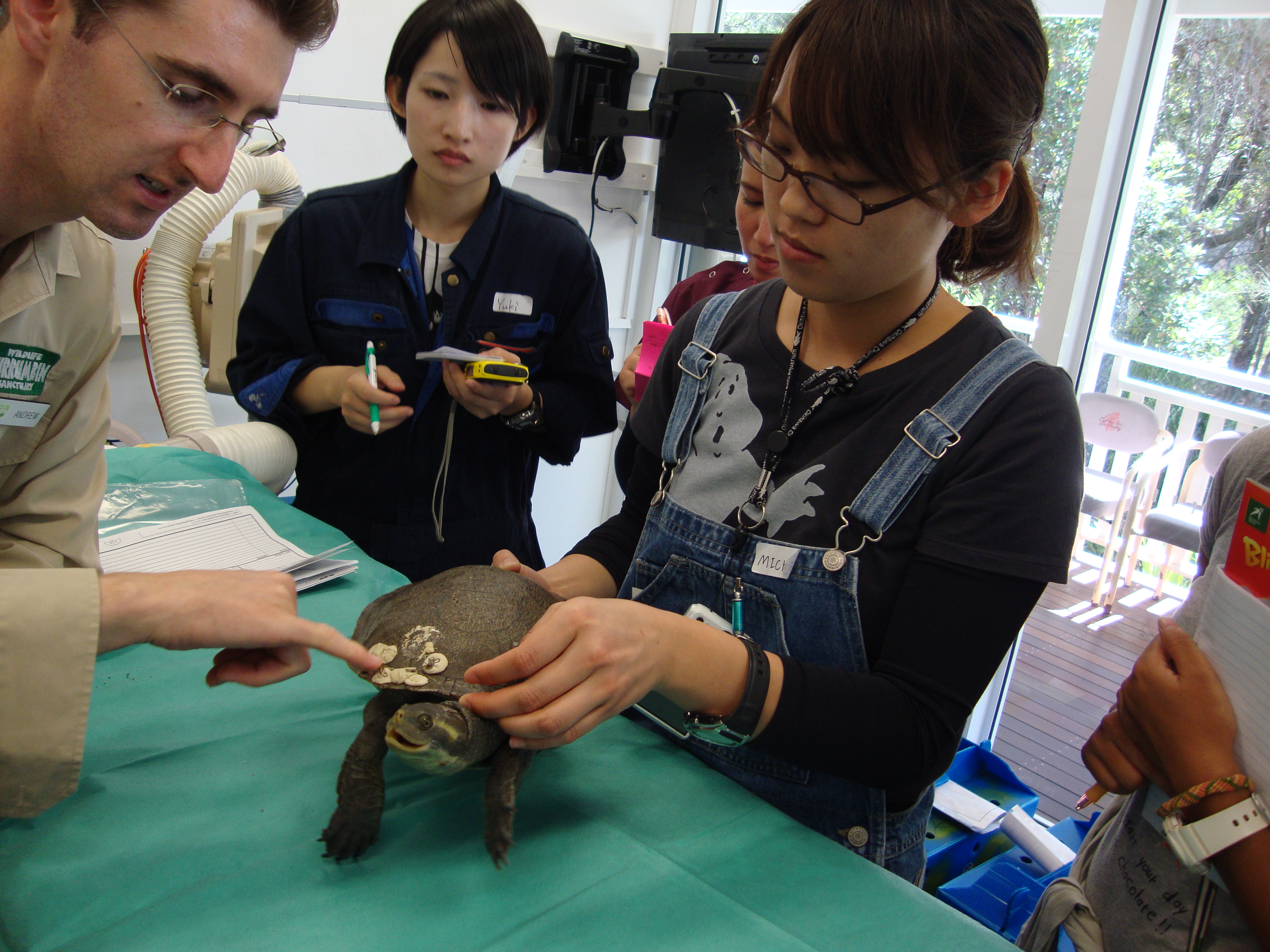 I found out about this
course 2 years ago when AJWCEF held a lecture at my university. It was there I
learnt about Moggill Koala Hospital, a hospital that specialised in treating
wild koalas, and that this course also involved training for living overseas. I found out about this
course 2 years ago when AJWCEF held a lecture at my university. It was there I
learnt about Moggill Koala Hospital, a hospital that specialised in treating
wild koalas, and that this course also involved training for living overseas.
In addition, one of the
sites visited during the course, Currumbin Wildlife Sanctuary (CWS) Wildlife
Hospital is an animal hospital specialising in wildlife that is run entirely on
donations and proceeds from the park. I had wondered about how veterinarians
were involved with wildlife in the past so the possibility of visiting a
facility like this that could not be seen in Japan made me want to know more
about the relationship between people and wildlife.
I
felt the bar was set very high if I was to work overseas in the future, so I
decided to do this program to get closer to that standard if even just a little.
There were 3 veterinarians
working at CWS Hospital and during the course wildlife was frequently being
brought into the hospital. In particular, I noticed unlike in Japan there were
2 – 3 times more vets involved in the treatment of wildlife, while day-to-day
care and office work was mainly conducted by volunteers.
It could be said that
animals are a valuable tourism resource and that is why there is a lot of
interest and concern for animals in Australia but I felt that wildlife was
immersed among people a lot more than in Japan. Even the feeding of wildlife
was becoming an event in a way.
I was able to see the
treatment and anatomy of many animals native to Australia, so their bodily
composition was completely different from animals in the Northern Hemisphere,
which was fascinating. Also, as part of the advanced course we were able to see
work of veterinarians up close, which made it easier to be aware of how as a
veterinarian it is possible to be involved in wildlife conservation. Every day
was stimulating and full of surprises; with such substantial contents, you
would not have thought it was only a weeklong training course.
Within the various talks I
had with Professor Mizuno, gThe truth is something you have to decide for
yourselfh and gJust because a pig is fat, it doesnft mean that it is happyh are
some of the things he said that left a lasting impression. I think there are
many things about Japan and myself that I just accepted and wonft understand if
I am content to stay in my comfort zone. So even domestically, I plan to live
my life with my eyes and ears open.
Finally, I would like to
thank Professor Mizuno, Ms. Toshimi, my fellow participants, the staff who made
the last 7 days so memorable and my parents.
Report
on the March 2015 Introductory Training Course Kanako Uematsu
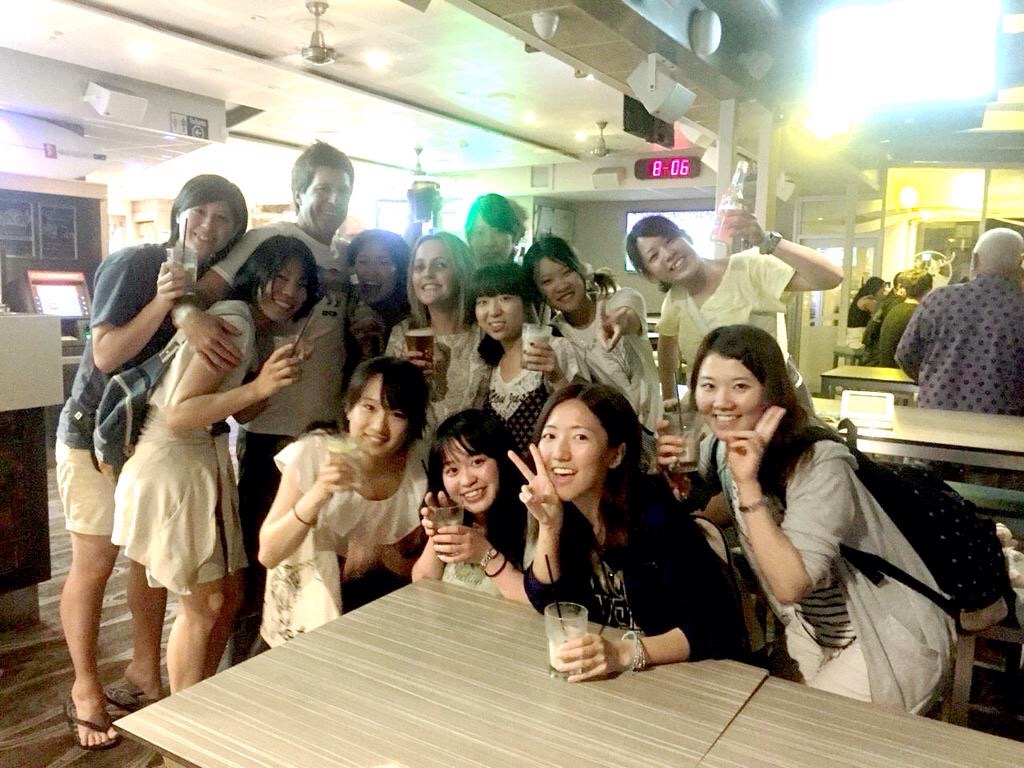 This was my first time participating in an AJWCEF training course. I was the
only one in the course from my university and at first I felt nervous about
spending two weeks overseas with people I had never met before. However,
everyone had a mutual love and interest in animals so through living together
and doing housework together we all soon became friends over time. When my
initial nerves changed to peace of mind, I began to enjoy every day as we spent
our nights figuring out together what to cook, where to go in our free time and
what to make for lunch the next day.
This was my first time participating in an AJWCEF training course. I was the
only one in the course from my university and at first I felt nervous about
spending two weeks overseas with people I had never met before. However,
everyone had a mutual love and interest in animals so through living together
and doing housework together we all soon became friends over time. When my
initial nerves changed to peace of mind, I began to enjoy every day as we spent
our nights figuring out together what to cook, where to go in our free time and
what to make for lunch the next day.
Also, the staff and locals didnft only talk about their work; they joined us at
outings and parties as well as interacting with us in a very friendly manner,
which meant the 2-week course was full of great memories.
In terms of study, we were able to experience things that could only be
done on this course such as checking the vitals and observing the behavior of
wildlife as well as the process of food preparation through to feeding the
animals. There was a lot to get out of this program as we interacted with the
animals, noticed their individual characteristics, learnt about their ecology and
learnt things from the rangers that only they knew from observing
the animals daily. As a result of participating in this course and the various
experiences it provides, it became clear to me what I want to do with my life.
Anyone who is unsure or lost about what to do in the future, you will find
something by participating in this course.
This course was not only about admiring wildlife, it also allowed me to
experience up close the serious problems that Australian animals are currently
facing, as well as the fine line between their life and death. It was a valuable
experience to learn the current state of the living world. Some things may
shock you but for those who have a strong will to learn about animals you will
be able to overcome this without a problem. Therefore, I would definitely
recommend you to participate in this training course and see for yourself.
Miyazaki University Faculty
of Agriculture, Department of Animal and Grassland Sciences 2nd Year
Shoko Matsumoto
I learnt about the Australia-Japan Wildlife Conservation and Education
Foundation when I was looking for activities that students could participate in
that involved wildlife. Although it was only for 2 weeks, leaving my school and
Japan to be able to experience a different culture, climate and ecosystem has
become an unforgettable and cherished memory.
The one thing that surprised
me most about life in Australia was that wildlife did not run away even if
people were nearby. It seems that since the Australian people do not pay
attention to the animals, the animals do not pay attention to them.
I was able to find out about
this difference in custom and mindset. Also, by talking to the volunteers and
staff at the facilities I felt the importance of taking an interest in the
animals in onefs own country.
After the tour finished, I
realized I want to learn more about the relationship between people and
wildlife as well as the cultures and wildlife in different countries. I want to
learn not only in the classroom but also by taking action, going around and
seeing things firsthand with my own eyes. I am grateful to all the staff that I
met and the friends I made with an interest in the same field. Thank you very
much.
Minori Kono
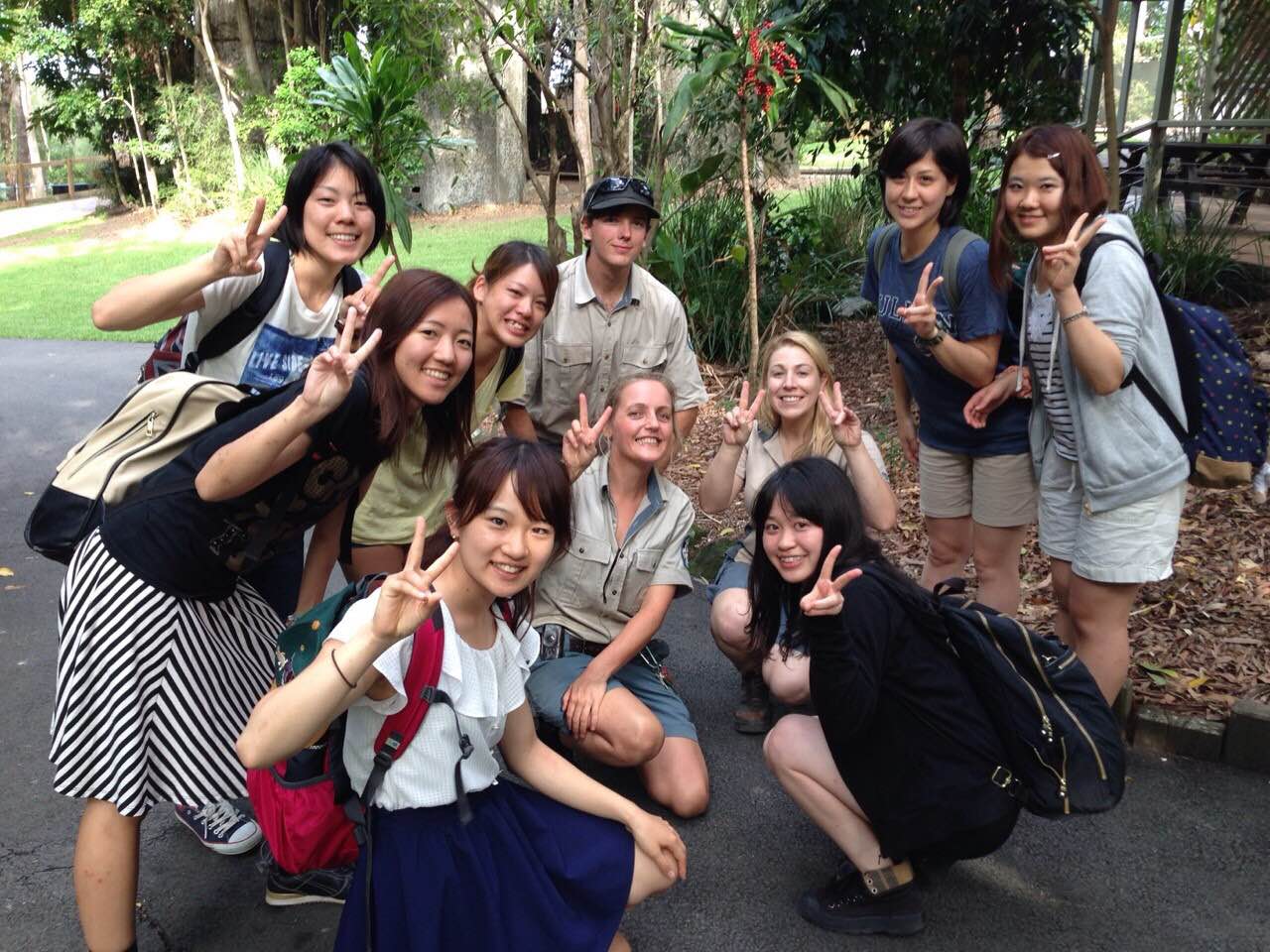 My goal is to have a career in wildlife conservation and participating in this
training course was the first step on that path. Despite being unable to speak
or understand any English, thanks to the other participants who I befriended
and the help of the teachers, it was an enjoyable and fulfilling training
course. My goal is to have a career in wildlife conservation and participating in this
training course was the first step on that path. Despite being unable to speak
or understand any English, thanks to the other participants who I befriended
and the help of the teachers, it was an enjoyable and fulfilling training
course.
The first part of the
training course took place at the David Fleay Wildlife Park where we helped the
rangers and were able to learn about the ecology of Australiafs unique wildlife
and how they are cared for and kept at the park. The rangers were really
friendly and approachable so it was easy to ask them anything we were unsure of
or had questions about.
The next part of the
training course was at Moggill Koala Hospital where we observed the
veterinarians using anatomical pathology (autopsy) and they explained the
various problems occurring in wildlife. In the morning we helped the volunteers
with some of the hospitalised koalas. We were able to hear from the volunteers
about why they started volunteering and what their feelings were towards
koalas.
We also went kayaking, saw
wild koalas, bats and pelicans, as well as visiting an actual wildlife carerfs
house and seeing how wildlife is cared for and specific adjustments made to the
room to cater for the wildlife. In addition, we visited the University of
Queensland and were shown what kind of environment local students were studying
in.
On the free day we went
shopping and had a good time at the beach. We had a party at our rental house
with the rangers as well.
I am grateful from the
bottom of my heart to everyone who made it possible for me to have such a
meaningful experience the past 2 weeks. In particular my friends who worked
through the training course with me every day, the teachers who taught us so
much as well as the rangers and volunteers.
I hope to utilize this
experience to pursue my future goals.
Report
on the August 2014 Introductory Training Course Saki Ito
Department of Veterinary
Science
Nippon
Veterinary & life Science University
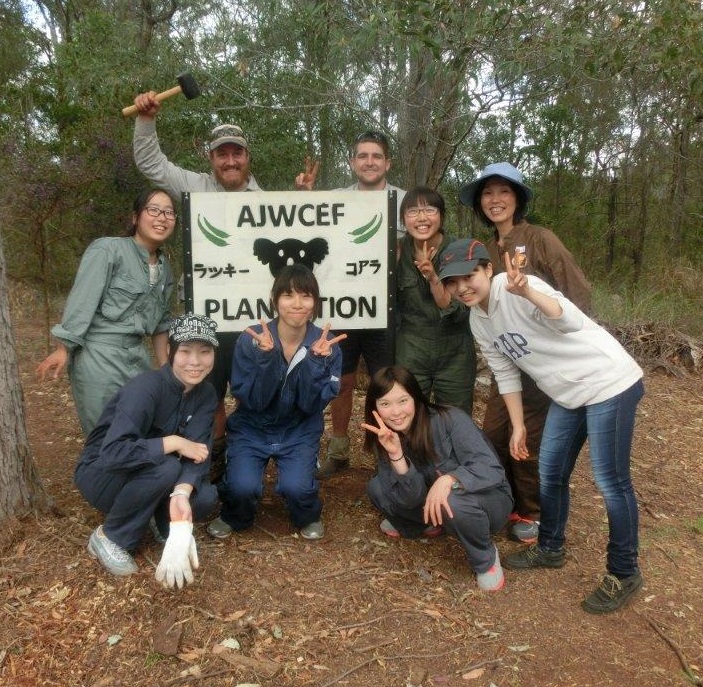 The training course I participated in was a really
meaningful time which afforded me the opportunity to be among the wonders of
nature and learn a lot with wonderful friends. Before the course, I wondered if
it might be a bit too long, but two weeks went by in a flash. The training course I participated in was a really
meaningful time which afforded me the opportunity to be among the wonders of
nature and learn a lot with wonderful friends. Before the course, I wondered if
it might be a bit too long, but two weeks went by in a flash.
The first week was spent at David
Fleays Wildlife Park, where we learned about the ecology and husbandry of a
variety of Australiafs unique animals. What I remember best is helping the
rangers to feed the animals and cleaning out the cages.
The
Moggill Koala Hospital was where we spent our second week. Here, we were taught
by veterinarians about anatomy and the types of illnesses that are a problem,
among other specialist knowledge. We also got to assist the volunteer workers
in taking care of the hospitalised koalas. It was a special opportunity to
learn through such opportunities as observing the autopsy of unique animals
that we could never see in Japan.
That
wasnft all that was in the variety-filled program. Some other activities included
kayaking, at which time we were able to spot wild koalas, a visit the home of a
wildlife carer, and a tour of the veterinary science facilities at the
University of Queensland. Each of these reinforced my impression that wildlife
conservation depends on the cooperation of a lot of people, and all of these
people are each acting in their own way with the animals at the forefront of
their mind. My hope is that one day I will be able to join this circle of
cooperation as a veterinarian, so I am determined to put even more effort into
my studies.
I also have to say that the Australian people who looked
after us were all warm, friendly and kind, and I am truly thankful to them for
enabling me to learn so much in such a fun way. I will treasure the memories of these people
and my experiences. Thanks for a great two weeks!
Report
on the February 2013 Introductory Training Course
Natsuko Sugiura - 3rd year student, Department of Veterinary Sciency, Nippon Veterinary & Life Science University. I
decided to participate in this course because I am hoping to work with
wildlife in the future, and because I had become interested in
Australia's unique animals such as marsupials and monotremes after
previously taking part in my university's study tour to Australia.
I was able to see many animals that just can't be seen in Japan, and
really got a feel for what it is like to take care of these creatures
and understand the problems that they face. Having learned
that many people in Australia
take part in wildlife conservation by volunteering to work at the koala
hospital and the like, and that there are facilities that only keep and
display Australia's unique animals, I gained the strong impression that
concern for and education about wildlife is stronger than in Japan.
Despite this, Australia shares some problems with Japan in the form of
the reduction and fragmentation of habitat due to development and
natural disasters, as well as issues surrounding introduced species,
and it was evident that wildlife conservation is no simple matter but
requires the understanding and cooperation of a large number of people.
A feature of this course is that it does not impose a certain way of
thinking or certain solutions to problems; rather, participants are
taught about the current circumstances and given food for thought about
how to resolve issues regarding wildlife and how humans and wildlife
can best co-exist. As such, there are many opportunities during the
course to consider such matters, which prompted me to also seriously
think about what I want to do in the future. I hope to put the
experience I gained from this course to full use to ponder how to
prevent the extinction of wildlife and how humans and animals can
co-exist in order to save as many wild animals as possible. Report
on the August 2012 Introductory Training Course
Kazane Arai – 4th year student, Division of Nature- and
Culture-based Tourism, Faculty of Urban Environmental Sciences, Tokyo
Metropolitan University@
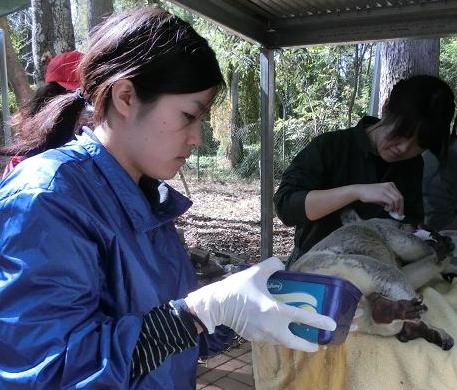 @Ifm so glad I joined this course! It was so evident that so many
different people – facility volunteers and staff, researchers, vets, rangers and AJWCEF staff are
all working as hard as they can to conserve wildlife and the environment, all
the while facing their own dilemmas, thoughts and distress. Being able to gain
this sort of information first-hand also provided me with a good opportunity to
think more deeply about myself and nature conservation. Also, although it was
only two weeks, it was really useful to sample ecommunal living,f cooperating
with companions I had only met for the first time upon arriving in Australia,
and sharing the cooking duties. While there may have been the occasional
disagreement or annoyance when sharing a room, I believe that learning to
overcome such issues is important in becoming a working member of society. @Ifm so glad I joined this course! It was so evident that so many
different people – facility volunteers and staff, researchers, vets, rangers and AJWCEF staff are
all working as hard as they can to conserve wildlife and the environment, all
the while facing their own dilemmas, thoughts and distress. Being able to gain
this sort of information first-hand also provided me with a good opportunity to
think more deeply about myself and nature conservation. Also, although it was
only two weeks, it was really useful to sample ecommunal living,f cooperating
with companions I had only met for the first time upon arriving in Australia,
and sharing the cooking duties. While there may have been the occasional
disagreement or annoyance when sharing a room, I believe that learning to
overcome such issues is important in becoming a working member of society.
Now, to those of you who
canft quite decide whether to take part in the course or not: just take the
plunge and give it a go. You wonft know until you try. There
is a reason for my enthusiasm in recommending this course; it is because I feel
that by participating I have gained ethe courage to take the first step.f I
hesitated at first because, being a student of tourism, I was concerned that I
would feel out of place since I am not a vet or involved in life sciences or
even agriculture. However, I love animals and nature and decided to just have a
try regardless of what I was studying, and it was the right choice. So, use all
your five senses to see what it is that you will feel and gain from the
experience.
Report on the March 2012
Advanced Training Course
Misato Hirai - 4th year student, Department of Zoology, Okayama
University of Science
 After participating in last yearfs introductory course, I decided to
take part in this yearfs advanced course offered in [the northern] spring. The content of the advanced
course was of an even higher level, allowing for more in-depth practical
training experiences. It was indeed a precious experience to undergo practical
training at wildlife parks and other wildlife hospitals to which one can
generally not gain access. By actually seeing the circumstances surrounding
wildlife, I was reminded of the difficulties associated with wildlife
conservation, such as the fact that it is not simply a matter of saving animals. After participating in last yearfs introductory course, I decided to
take part in this yearfs advanced course offered in [the northern] spring. The content of the advanced
course was of an even higher level, allowing for more in-depth practical
training experiences. It was indeed a precious experience to undergo practical
training at wildlife parks and other wildlife hospitals to which one can
generally not gain access. By actually seeing the circumstances surrounding
wildlife, I was reminded of the difficulties associated with wildlife
conservation, such as the fact that it is not simply a matter of saving animals.
Rather than just the study
of animals, I believe that interaction with various people is also an important
element of this training course. I was able to renew my acquaintance with some
of the people I had met during last yearfs introductory course. It was a lot of
fun to spend two weeks with friends, learning about wildlife, and shopping and
eating together; it was great to support each other as we spent our time in a
culture that is different from our own. Of the four people who took part in the
advanced course, two were studying to be veterinarians, while I and another
participant were zoology students. Despite differences in age, universities and
fields of study, we helped each other out when we came upon new things, adding
extra stimulus to enhance our learning.
Through this training course, my own perspective became broader
by actually seeing and experiencing things for myself. I was able to undertake both the
introductory and the advanced training courses, and I intend to apply the
knowledge and experiences that I garnered from both in my future studies. Ifll also be furthering my
studies in Japan with the aim of revisiting Australia to learn more about
wildlife. Report on the February 2012 Introductory Training
Course Yuto Yoshimoto – 2nd year, Veterinary Medicine, Faculty of Agriculture,
Tokyo University of Agriculture & Technology
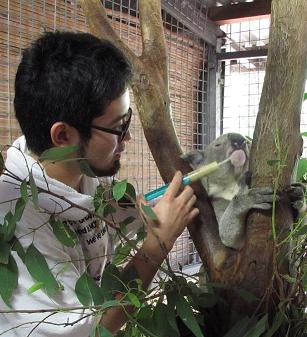 By participating in this training course, I was able to gain basic
knowledge regarding
Australian wildlife, their current circumstances, and the respo Bynse to those circumstances. In Australia,
wildlife is regarded as belonging to the nation, with protection activities
conducted under a policy of considering the entire ecological perspective. Australia
is much more active in this area than Japan whether you look at the facilities,
systems or even the number of people involved in protection, and the people
seemed to have a greater awareness of the issues. Having said that, not all the
activities are necessarily helpful, and there was much food for thought. By participating in this training course, I was able to gain basic
knowledge regarding
Australian wildlife, their current circumstances, and the respo Bynse to those circumstances. In Australia,
wildlife is regarded as belonging to the nation, with protection activities
conducted under a policy of considering the entire ecological perspective. Australia
is much more active in this area than Japan whether you look at the facilities,
systems or even the number of people involved in protection, and the people
seemed to have a greater awareness of the issues. Having said that, not all the
activities are necessarily helpful, and there was much food for thought.
And I
didnft learn just about wildlife; learning to interact with people was also a
significant plus that I gained from this training course. Everyone involved in the course - from
other participants, to AJWCEF staff members, the vets at the
training facilities and the rangers – were all very friendly and made it a very
enjoyable two weeks. Although
I was feeling less than confident about my English conversation skills given
that the training was conducted overseas, I was really happy that I somehow
managed to communicate with my broken English! Not only did this give me
confidence, but it also drove home the importance of English language skills.
This
training course strongly stimulated both my interest in wildlife and my
approach to going overseas. If I have the chance, I would also like to take
part in the advanced training course. It would be wonderful if future
participants in the course are also able to enjoy the same experience that I
did.
@
University Students
Even though there are efforts to raise awareness in Japan through school education
and the media that wildlife numbers are dwindling and that we should be
protecting them, there is a vast distance between humans and wildlife that is not
seen elsewhere. While I previously had a vague interest myself in wildlife
conservation, I had neither sought a deeper understanding of the actual
circumstances they were in nor made any effort to protect them. The best aspect of this practical
training was that it showed me, no matter how limited, something of the actual
situation regarding wildlife protection in Australia, and allowed me to speak
with those involved in it. It was the first time that I was prompted to give
any real thought to how the phenomenon of declining wildlife numbers has
arisen; what we as humans have to do; that, although wildlife must be
protected, it is no easy feat to do so (every country faces the dilemma of
having to strike a balance between development to sustain its citizens while
protecting the environment, and considering the overall balance of the
ecosystem in the process); and just what is protection and what is its purpose.
I believe that I need to continue to learn about such matters,
discuss them with others and put into action whatever it is that I can do as a
citizen of this planet. I am most grateful to Dr. Mizuno and the AJWCEF staff
for providing me with such an opportunity, and to the people at DFWP and the
Moggill Koala Hospital who made the training so meaningful.
|